
Vincent Willem van Gogh was a Dutch Post-Impressionist painter who is among the most famous and influential figures in the history of Western art. In just over a decade, he created approximately 2100 artworks, including around 860 oil paintings, most of them in the last two years of his life. His oeuvre includes landscapes, still lifes, portraits, and self-portraits, most of which are characterized by bold colors and dramatic brushwork that contributed to the rise of expressionism in modern art. Van Gogh's work was beginning to gain critical attention before he died from a self-inflicted gunshot at age 37. During his lifetime, only one of Van Gogh's paintings, The Red Vineyard, was sold.

Lust for Life is a 1956 American biographical film about the life of the Dutch painter Vincent van Gogh, based on the 1934 novel of the same title by Irving Stone which was adapted for the screen by Norman Corwin.
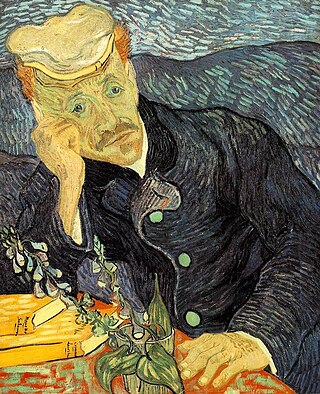
Portrait of Dr. Gachet is one of the most revered paintings by the Dutch artist Vincent van Gogh. It depicts Dr. Paul Gachet, a homeopathic doctor and artist with whom van Gogh resided following a spell in an asylum at Saint-Rémy-de-Provence. Gachet took care of Van Gogh during the final months of his life. There are two authenticated versions of the portrait, both painted in June 1890 at Auvers-sur-Oise. Both show Gachet sitting at a table and leaning his head on his right arm, but they are easily differentiated in color and style. There is also an etching.

Auvers-sur-Oise is a commune in the department of Val-d'Oise, on the northwestern outskirts of Paris, France. It is located 27.2 km (16.9 mi) from the centre of Paris. It is associated with several famous artists, the most prominent being Vincent van Gogh (1853–1890). This was the place where van Gogh died.

Paul-Ferdinand Gachet was a French physician most famous for treating the painter Vincent van Gogh during his last weeks in Auvers-sur-Oise. Gachet was a great supporter of artists and the Impressionist movement. He was an amateur painter, signing his works "Paul van Ryssel", referring to his birthplace: Rijsel is the Dutch name of Lille.
Vincent van Gogh lived during the Impressionist era. With the development of photography, painters and artists turned to conveying the feeling and ideas behind people, places, and things rather than trying to imitate their physical forms. Impressionist artists did this by emphasizing certain hues, using vigorous brushstrokes, and paying attention to highlighting. Vincent van Gogh implemented this ideology to pursue his goal of depicting his own feelings toward and involvement with his subjects. Van Gogh's portraiture focuses on color and brushstrokes to demonstrate their inner qualities and Van Gogh's own relationship with them.
The fame of Vincent van Gogh began to spread in France and Belgium during the last year of his life, and in the years after his death in the Netherlands and Germany. His friendship with his younger brother Theo was documented in numerous letters they exchanged from August 1872 onwards. The letters were published in three volumes in 1914 by Johanna van Gogh-Bonger, Theo's widow, who also generously supported most of the early Van Gogh exhibitions with loans from the artist's estate. Publication of the letters helped spread the compelling mystique of Vincent van Gogh, the intense and dedicated painter who died young, throughout Europe and the rest of the world.

The Roulin Family is a group of portrait paintings Vincent van Gogh executed in Arles in 1888 and 1889 of Joseph, his wife Augustine and their three children: Armand, Camille and Marcelle. This series is unique in many ways. Although Van Gogh loved to paint portraits, it was difficult for financial and other reasons for him to find models. So, finding an entire family that agreed to sit for paintings — in fact, for several sittings each — was a bounty.
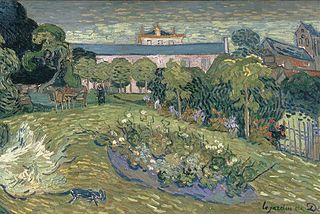
Daubigny's Garden, painted three times by Vincent van Gogh, depicts the enclosed garden of Charles-François Daubigny, a painter whom Van Gogh admired throughout his life.
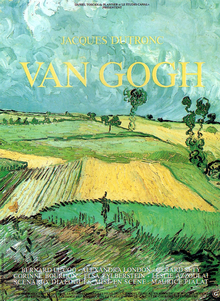
Van Gogh is a 1991 French biographical drama film written and directed by Maurice Pialat. It stars Jacques Dutronc in the role of Dutch painter Vincent van Gogh, for which he won the 1992 César Award for Best Actor. Set in 1890, the film follows the last 67 days of Van Gogh's life and explores his relationships with his brother Theo, his physician Paul Gachet, and the women in his life, including Gachet's daughter, Marguerite.
BreakThru Films is an independent film production company based in Sopot in Poland. Founded in 2002 by Hugh Welchman and initially based in the United Kingdom. The company concentrated mostly in the production of short films, animation, documentary and live-stage shows but has since focused mainly on feature films. Their 2006 short film Peter and the Wolf was awarded an Academy Award for Best Animated Short Film and their 2017 feature film Loving Vincent was Academy nominated for Academy Award for Best Animated Feature.
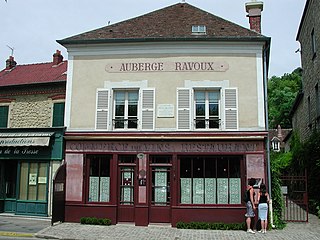
The Auberge Ravoux is a French historic landmark located in the heart of the village of Auvers-sur-Oise. It is known as the House of Van Gogh because the Dutch painter Vincent van Gogh spent the last 70 days of his life as a lodger at the auberge. During his stay at Auvers, Van Gogh created more than 80 paintings and 64 sketches before shooting himself in the chest on 27 July 1890 and dying two days later on 29 July 1890. The auberge (inn) has been restored as a museum and tourist attraction. The room where Van Gogh lived and died has been restored and can be viewed by the public.

Girl in White was painted by Vincent van Gogh in 1890 in Auvers-sur-Oise, France, during the last months of his life. Girl in White has been part of the Chester Dale Collection in the National Gallery of Art, Washington D.C. since 1963.

Vincent van Gogh enjoyed making Paintings of Children. He once said that it's the only thing that "excites me to the depths of my soul, and which makes me feel the infinite more than anything else." Painting children, in particular represented rebirth and the infinite. Over his career Van Gogh did not make many paintings of children, but those he completed were special to him. During the ten years of Van Gogh's career as a painter, from 1881 to 1890, his work changed and grew richer, particularly in how he used color and techniques symbolically or evocatively.

Dr. Gachet's Garden in Auvers and Marguerite Gachet in the Garden were both painted in 1890 by Vincent van Gogh in the gardens of his homeopathic physician, Dr. Paul Gachet. Both paintings reside at the Musée d'Orsay.

The death of Vincent van Gogh occurred in the early morning of 29 July, 1890 in his room at the Auberge Ravoux in the French village of Auvers-sur-Oise after presumably shooting himself two days earlier.
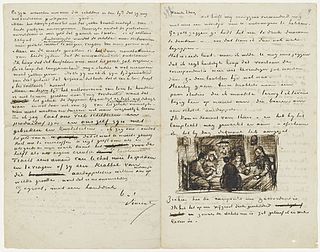
The Letters of Vincent van Gogh is a collection of 903 surviving letters written (820) or received (83) by Vincent van Gogh. More than 650 of these were from Vincent to his brother Theo. The collection also includes letters van Gogh wrote to his sister Wil and other relatives, as well as between artists such as Paul Gauguin, Anthon van Rappard, and Émile Bernard.

Hugh Stewart Jasper Welchman is a British filmmaker, screenwriter, and producer.

DK Welchman is a Polish filmmaker, screenwriter, and producer. She is best known for co-directing her first fully painted animated feature film Loving Vincent (2017) with her husband Hugh Welchman.

At Eternity's Gate is a 2018 biographical drama film about the final years of painter Vincent van Gogh's life. The film dramatizes the controversial theory put forward by van Gogh biographers Steven Naifeh and Gregory White Smith, in which they speculate that van Gogh's death was caused by manslaughter rather than suicide.


















